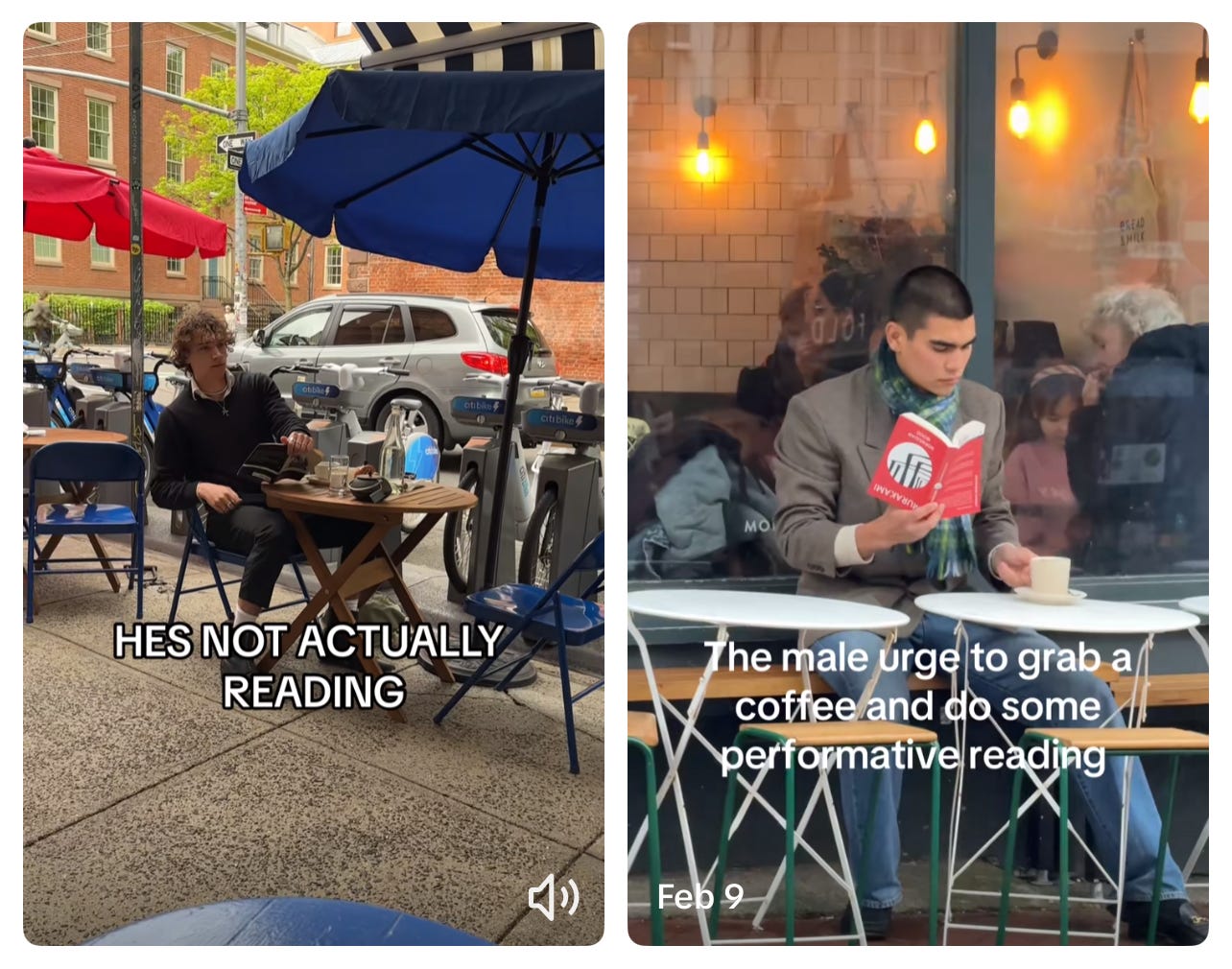should men listen to clairo and grab matcha?
oh! so you like feminist literature, should we throw a party? should we invite bell hooks?
Picture this: a man walks into a café, places his copy of feminist literature deliberately on the table, and adjusts the drape of his thrifted canvas jacket with the precision of someone who knows he’s being watched. He approaches the counter with that grounded presence men adopt when they’ve recently learned the word “boundaries.” There’s an eyebrow piercing. He orders a matcha with exaggerated softness, then returns to his seat, slips in his wired earphones, blasts Clairo, and opens Eve Babitz like he’s handling sacred text.
Does he genuinely love these things, or is this all performance?
Lately, every corner of the algorithmic ether Instagram, TikTok, Twitter (I refuse to call it X, sorry), the whole digital wasteland, has been preoccupied with the phenomenon of performative men. The ones who weaponize soft-boy aesthetics and sprinkle in just enough feminist vernacular to seem evolved. A nail painted here, a lowercase boygenius lyric there. Emotional literacy as mating call. The entire endeavor of listening to “10:36” by beabadoobee becomes less about the music and more about engineering a moment where someone might ride them before the night ends. Tenderness not as truth, but as tactic.
And to this, I say two things:
Carrying feminist literature does not render you intellectual—it merely reveals your desire to be seen that way. We can all see the spine of the book, no one’s impressed.
We talk a lot about "performative men" these days, the ones who adopt the aesthetic markers of emotional depth and feminist awareness because these things are now culturally valuable. But performance, in this sense, isn’t exclusive to men. Everyone, at some point, performs. Because we’re all online, and online is a stage.
Still, there’s a particular tension when it comes to the way men engage with traditionally “feminine” or “soft” cultural artifacts; feminist literature, introspective indie music, certain aesthetics of vulnerability. These things were once derided by the same audiences that now romanticize them. So when men do engage with them today, it can be difficult to tell whether that engagement is rooted in genuine curiosity or simply opportunism.
But maybe that’s the wrong question.
Maybe the better question is: why have we all become so obsessed with the optics of taste?
Social media has blurred the line between what we like and what we’re seen liking. Books, once private encounters between a reader and the page, now often double as props in a personal brand. You don’t just read Didion, you’re “a Didion girl.” You don’t just enjoy Camus, you’re “the Camus guy.” These categories— constructed through shared aesthetics, tropes, and memes— offer us a way to self-identify, to belong. But they also flatten our experiences into consumable signals. It becomes less about the text, and more about what the text says about you.
This creates a strange dynamic: on one hand, it’s deeply human to want to be seen, to build identity through what we love. On the other, it’s easy to lose the actual substance beneath all that self-fashioning. Reading becomes less about thinking, and more about proving. Listening becomes less about emotion, and more about alignment.
It’s not just men who are guilty of this, though the criticism is often directed at them, perhaps because their engagement with emotional or feminist texts is more recent, more visible, more sudden. But this phenomenon reflects broader societal pressures: to keep up, to signal awareness, to be on the right side of taste. And in this environment, even sincerity can start to feel suspect. We begin to second-guess everyone’s motivations, including our own. Am I reading this because I want to? Or because I want to be the kind of person who reads it?
The irony is that while we criticize others for “performative reading,” we often do so performatively. There’s a moral superiority in saying you read things “before they were cool,” in distancing yourself from the TikTok girlies who found Sylvia Plath in a listicle. But what’s really the difference between reading a book to be perceived as smart, and mocking someone else for reading it to be perceived as smart? Either way, we’re still prioritizing perception.
It’s also worth considering that engagement, even if initially performative, can be a pathway into something deeper. Maybe someone picks up The Second Sex to impress a girl, but actually finds themselves drawn into questions about power, gender, and identity. Maybe the curated Spotify playlist leads to real emotional excavation. Maybe the aesthetic starts as costume and becomes a second skin. The road to genuine interest isn’t always pure. Sometimes, it starts with mimicry.
And maybe that’s okay.
We are all, in one way or another, trying to find footing in a culture that renders every facet of our identity (our preferences, vulnerabilities, even our silences) as visible, consumable data. Within that architecture, cynicism becomes a reflex. We begin to doubt authenticity, to view every expression as strategy, every book spine as performance. But in doing so, we forget something elemental: people are in flux. We are not fixed creatures, but ones constantly in the process of becoming. And sometimes, performance is simply the threshold to sincerity.
So the more nuanced question isn't whether someone is engaging with literature, or music, or film, for show. It’s whether they are open to being changed by that engagement. Whether what begins as mimicry might, with time and honesty, evolve into something more rooted, more real.
Rather than asking, “Does he actually care about this?”— perhaps we should ask why we’ve become so terrified of being misread. Why the love of something must be accompanied by proof of legitimacy. Why we’ve come to treat cultural affinity like credentialing, as though taste must be defended rather than lived.
Taste is not a CV. Loving something, truly loving it, isn’t a performance, but neither is it a fully formed personality. It’s a beginning. A gesture toward who we are trying to become. And there is grace in allowing that to be enough.
Engage with art for what it is, not for what you think it might earn you—whether that’s validation, sex, or the aesthetic approval of a girl in fishnets who’ll call you “deep” as you play her a Mitski record on vinyl.
There was once a quiet sanctity in art. A kind of interiority. You watched a film, read a book, listened to a record, and it stayed with you, echoed privately in your mind, pressed softly against your ribs. It lingered not because you shared it, but because you didn’t have to.
Now, nothing is real unless it is performed.
What once lived in solitude now demands an audience. We no longer simply engage with art: we curate it, brand it, aestheticize it for others. A bookshelf is no longer a place of reverence but a backdrop. A Letterboxd log, not a record of what moved us, but a catalog of what we hope will make us appear more intelligent, more romantic, more “in the know.” Taste has become its own genre of social currency—performative, ornamental, endlessly optimized for perception.
To love something, today, is to wonder: will this make me more interesting if I’m seen loving it?
And therein lies the shift: art, once a vessel for interior transformation, is now often reduced to an accessory to self-image. A soundtrack for seduction. A line-item on a dating profile. A performance piece in the theatre of being perceived. What you enjoy no longer speaks to who you are, but to who you want to be seen as.
It’s not just about men performing sensitivity for clout, reading Virginia Woolf on café patios, quoting Toni Morrison between sips of matcha. It’s about all of us. Performing taste like it’s demanded from us. Interacting with culture as a branding exercise. Learning to ask not “What did this make me feel?” but “What will this say about me if I post it?”
We rate films in stars, not feelings. We log books before we've digested them. We screenshot lyrics, highlight quotes, post them not because they haunt us, but because they might perform well. There’s a dissonance in this performance: we pretend we’re documenting our inner lives, when in fact we’re designing them to be palatable, legible, aspirational. The archive becomes a mirror, but one we’re endlessly polishing for others to see.
Even the platforms meant to celebrate culture (Goodreads, Letterboxd, Substack) have become metrics machines. They began as tools for reflection; they became scoreboards. What began as a private practice now feels like a tournament: who’s seen the most, read the deepest, said the cleverest thing? When taste becomes competitive, the art itself fades, hollowed out by the need to seem.

And the tragedy of performance is not just that it’s tiring— it’s that it’s flattening. The strange, slow, interior work of engaging with art is hard to quantify. How do you log the novel that didn’t move you until three months later? How do you rate the film that unsettled you, then comforted you, then left you speechless for reasons you can’t explain? These moments resist articulation, and so they vanish from feeds, lost in favor of something neater, more captionable, more quickly consumed.
In this way, we begin to confuse visibility with validity. If no one saw it, did it even matter that you felt it?
And yet, despite all this, we return to art. Because in its essence, it still has the power to resist. Even within a commodified ecosystem, art continues to offer something sacred: the chance to feel profoundly, even privately. To encounter ourselves in the act of looking. To sit with discomfort, with beauty, with contradiction. To be changed, not advertised. Perhaps the most radical thing we can do, then, is to reclaim intimacy with the things we love. To read something and not post it. To watch a film and resist the urge to rate it. To love a song and let it remain yours alone. Not because sharing is wrong, but because privacy has power. Because everything doesn’t need to become content to be meaningful.
Art is not meant to decorate the performance of a self. It’s meant to undo the self, little by little. To create small ruptures in your understanding of the world. To let you reassemble in the quiet. And the most beautiful thing is: you don’t owe anyone a record of that transformation. You’re allowed to keep the mystery. You’re allowed to be changed, and not explain how.
In a world that rewards spectacle, perhaps the real rebellion is this: to engage deeply, sincerely, and in silence. To love things for how they touch you— not how they frame you. To remember that art, in the end, was never about being seen. It was about seeing.
And so…
There’s a particular tension in craving originality while fearing the inevitable commodification of your identity. Being different—genuinely, earnestly so—can feel like a small kind of freedom. It’s liberating, even grounding, to stand apart and still find kinship with those who share your experiences or obsessions.
However, the moment that authenticity becomes visible, it risks being consumed. Suddenly, what once felt intimate and singular, your taste, your humor, your culture, your pain, becomes aestheticized, flattened, marketable. The feeling of being “different” morphs into a brand. Your uniqueness becomes content. Your identity becomes trend-able, exportable, clickable.
What began as a source of connection—“this is who I am, and maybe it’s who you are too”—turns into a performance loop. And suddenly, you’re watching people cosplay the very thing that shaped you, minus the nuance, minus the history, minus the cost. Your liberation becomes someone else’s look. Your lived experience gets filtered through algorithms, packaged as relatability, and sold back to you on tote bags and TikToks.
This is the paradox of being perceived in the age of curation: the more you reveal in search of solidarity, the more you risk being abstracted from yourself. And the real ache of it all is that the original feeling—that intimate spark of recognition with someone who just gets it—is still what we’re all chasing. But now we have to navigate layers of mimicry, marketing, and performance to find it again.
So you start wondering: do I hide what I love, just to protect it? Do I stay silent about my identities, just to keep them from being diluted? Or is there still a way to be real in a world that’s built to monetize the real?
There’s something fundamentally hollow about reducing taste to currency. Authenticity is not a performance metric. And let’s be clear: this isn’t just about men. We’re all guilty, in some way, of curating ourselves into palatable personas. But maybe, loving something for its own sake could be enough.
thank you so so much for reading, and let me know your thoughts (either through comments + personally messaging me)!!
love, m!







I don't think performative art consumption is new. Opera and theatre have been status symbols for centuries, and lots of wealthy go there because they have to, not because they enjoy it.
And posers have been a thing for as long as subcultures have been around.
As for men liking traditionally female culture I think there are two parts to it. One is men performing to attract a woman. Other one is that even if man isn't performing, and truly enjoys it, women find it as an invasion of the female space.
I enjoy listening to Mitski and Lana Del Rey, I don't identify with either, you can enjoy music without identifying with the lyrics. But I have had women tell me that I shouldn't be allowwd to listen to Mitski.
Most male spaces are male because women don't want to be there, not because there are rules against them being there. The only female space I know of like that is fujochan.
this is so real... somedays i don't even know who i am anymore. do i like things because i truly like them or because i want people to view me as a person who likes these things? i'm the no. 1 victim of judging others for their tastes yet i'm the same person who saves a shit ton of books in my goodreads' want to read and fail to give reviews more detailed than 4/5 stars lol